
The Rev. Burrell Cannon (1848-1922)
The Rev. Burrell Cannon (1848-1922) In 1898, everyone wanted to invent a flying machine. Huge prizes were offered in London, Paris and New York for the first successful "heavier than air" craft which could carry man. In Pittsburg, Texas, a Baptist minister who was also a skilled inventor made history with his craft! Rev. Burrell Cannon's Ezekiel Airship !
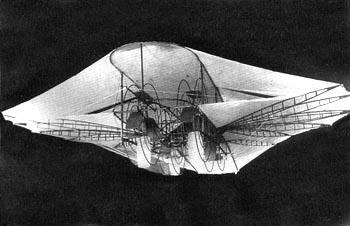 Ezekiel Airship : Contemporary Postcard download a 750pixel image http://www.pittsburgtxmuseum.com
Before the Wright Brothers had their plane in the air over Kitty Hawk, N.C. in 1903, an East Texan had designed an Airship that could fly and had raised funds to build it. The Rev. Burrell Cannon (1848-1922), pastor of the Baptist Church in Pittsburg, Texas was the inventor of the Ezekiel Airship and in August of 1901, he convinced his acquaintances that his Airship would fly and that it could be maneuvered by a lever within the inner wheel. This allowed for vertical take-off.
Rev. Cannon made the Bible his life study, and it was from the Book of Ezekiel that he got the idea for his wheel-within-a-wheel Airship. "The appearance of the wheels and their work was like unto the color of beryl; and they four had one likeness; and their appearance was as it were a wheel within the middle of the wheel." (Ezekiel 1:16) 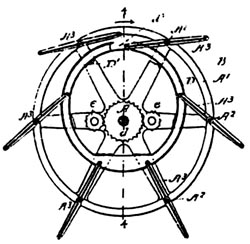 Ezekiel Airship : The Wheel Concept
Burrell Cannon was a minister, but made his living as a sawmill operator. He was a skilled machinist and mechanic and had 9 other patents for wind-driven machine to his credit.
He had credibility! His stock company raised $20,000.00 and the first Ezekiel Airship was built in Pittsburg, Texas at P.W. Thorsell's Foundry. Upon completion, the Airship was shipped by rail to St. Louis where it was to be exhibited. A storm blew it off the flat bed car near Texarkana, Texas and the first model was completely destroyed. 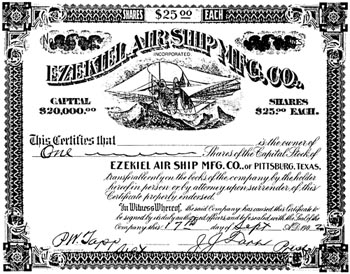 Ezekiel Airship : Stock Certificate download a 1000pixel image
After the destruction of the first aircraft, Rev. Cannon moved to Longview where he attempted unsuccessfully to construct a second airship. It is reported that he felt the first one would not fly because the motor (gasoline driven) was too heavy. There is no factual documentation that it ever flew, but witnesses in Pittsburg as late as the 1960's swore they saw it lift off over a fence near the building where it was built. The airship is not only the work of a skilled mechanic in a time of world obsession with flying, but it is a tremendous statement of his faith in God, and in his ability to interpret the Scriptures. This replica was constructed in 1986 by a skilled local craftsman working from the only known photograph of the airship. At the time of his death in 1923 at age 74, Rev. Cannon was working to develop a connon-picker and boll-weavil destroyer.
"And when the living creatures went, the wheels went by them; and when the living creatures were lifted up from the earth, the wheels were lifted up." (Ezekiel 1:19) 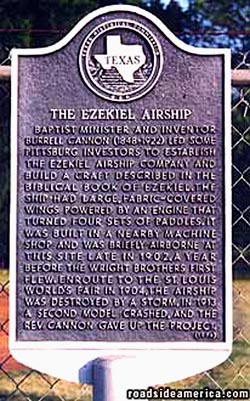 The Ezekiel Airship - 18"x28" Official Texas Historical Marker Camp County (Order #4691) 11/5/96. Location: Fulton Street, Pittsburg, Texas.
A Flying Start http://www.dallasnews.com
Some say it's possible an East Texas invention beat the Wright brothers into the air "Our goal is to build a building large enough to house the entire airship," said Pittsburg Mayor D.H. Abernathy. "We think this airship is worth seeing." Jon Freilich / The Dallas Morning News "Our goal is to build a building large enough to house the entire airship," said Pittsburg Mayor D.H. Abernathy, whose reflection is seen in the mirrored case holding a model of the aircraft. PITTSBURG, Texas - Some say the race to conquer the skies was won by a Baptist minister in East Texas a year before the Wright brothers ever hauled their flying machine to the windswept dunes of Kitty Hawk. The aircraft - a canvas and wood contraption that resembled a cross between a dragonfly and a Conestoga wagon - was known as the Ezekiel Airship, named for the book in the Bible from which the Rev. Burrell Cannon said he received his inspiration to build it. And if four witnesses told the truth, a man who helped build the Ezekiel Airship hopped behind the controls one Sunday morning in late 1902, fired up its 80-horsepower engine and briefly took the ship aloft to a height of 12 feet above a pasture at the edge of downtown Pittsburg. Wilbur and Orville Wright were not to make their historic 120-foot, 12-second flight until Dec. 17, 1903.
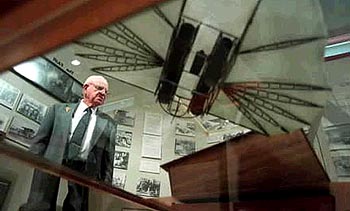 Lacy Davis and above, The Ezekiel Airship
Experts who have studied a replica of the Ezekiel Airship now on display at the Camp County Museum in downtown Pittsburg say they doubt the aircraft ever performed like a traditional airplane. http://www.dallasnews.com/millennium/0520flying.htm
Ezekiel's Wheel
The 1st U.S. Aircraft! NOT the Wright Brothers - Not Kitty Hawk Inspired by the 1st and 10th Chapters of the Book of Ezekiel in the King James version of the Holy Bible, Baptist Minister Burrell Cannon designed and constructed this airship, several years prior to the Wright brothers first flight. An accomplished engineer, Rev. Cannon held numerous patents for wind and water-driven machines, in times which preceded electricity. Judge for Yourself! Could this airship fly? Whether it did or did not fly, it stands as a testament to one man's faith in God and Holy Scripture. Rev. Burrell Cannon was a visionary Baptist preacher, but was an accomplished engineer and held several patents relating to wind-driven water pumps, windmills, etc. in a day and age without electricity. The design of this airship includes complicated but ingenious design features for propulsion and control of the craft which are marvels of engineering and mathematical calculations. While modern engineers may debate its ability to actually fly, it was certainly a very serious project in its day. Rev. Cannon believed he was led by God to design and build the ship and God would insure its success. Here is how Rev. Cannon propelled and controlled the Craft: PROPULSION. Four large outside wheels in the fuselage section contain smaller wheels which contain paddles. The gas engine turned the wheels and paddles at a rapid rate, creating, vertical and horizontal blasts of air which moved the machine forward as well as providing upward air flow to assist in flying and controlling, the craft. The'-paddles are pivoted, and on eccentric wheels, so that when the control levers were moved, the paddles on each side would create smaller, or larger, amounts of propulsion by controlling their angle of attack on the atmosphere. CONTROL: The ship would be turned by varying the amount of airflow on each side with each set of paddles, and by varying the angle of the sail. Four small, brass hydraulic cylinders in the vertical corner posts of the fuselage, would raise or lower the sail from front to rear, or side to side. coordinated with the paddles, and thus allow the ship to do what is known in modem aviation as "side-slipping." This would run the airship, or make it rise or descend, depending on the angle of the sail and control of the airflow with the paddles. THE ENGINE: The four-cylinder engine, hand-made at the Foundry where the craft was constructed is described as a "gas" engine. It does not specify if it was "gasoline" or something more like "natural gas". Rev. Cannon's notes do indicate the "gas" was contained in the hollow tubing from which the fuselage was constructed, as there appears to be no fuel tank aboard. Rev. Cannon was very secretive about his engineering solutions, so this project is barely mentioned at all in the Pittsburg Gazette during the two years the ship was under construction in Mr. P. W. Thorsell's Pittsburg Foundry. Engineers and aviation buffs all over the world (including, the Wright Brothers) were attempting to develop heavier-than air crafts of all sorts hence the secrecy surrounding the project-- to prevent others from stealing Rev. Cannon's ideas. ...more
|
© Copyright 1999-2002 CTIE - All Rights Reserved - Caution |